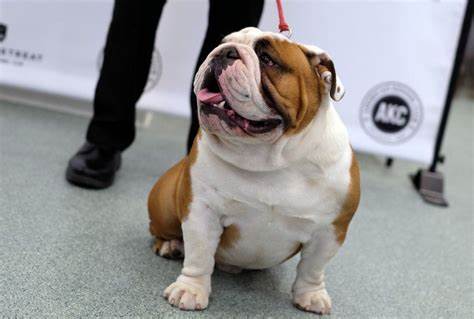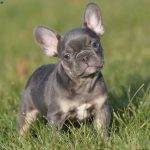What Is the Biggest Bulldog Breed?
Bulldogs have been around since ancient times, and they come in a variety of shapes, sizes, and colors.
They are known for their friendly and affectionate personalities, making them great companions for both children and adults alike.
In this article, we will explore what is considered to be the biggest bulldog breed—the English mastiff—as well as some of its pros and cons when it comes to ownership.
History of Bulldogs
Contents
- 1 History of Bulldogs
- 2 Overview of Different Bulldog Breeds
- 3 Characteristics of Bulldogs
- 4 The Biggest Bulldog Breed – English Mastiff
- 5 Pros and Cons To Owning an English Mastiff
- 6 Health Concerns for the English Mastiff
- 7 Exercise Requirements for the English Mastiff
- 8 Training Requirements for the English Mastiff
- 9 Is The English Mastiff Right For You?
- 10 Conclusion
Bulldogs have a long history that dates back hundreds of years in England, where they were used as guard dogs or fighting dogs in bull-baiting events that involved pitting a dog against a bull in a ring or arena.
After these events were outlawed, people began breeding them down into smaller sizes so that they could become family pets instead. So, we know today that there are such as French bulldogs, American bulldogs, and more.
Overview of Different Bulldog Breeds
There are many different types of bulldogs out there today, ranging from small breeds like Frenchies to larger breeds like Olde English Bulldogges and American Bullies.
Some common characteristics found among all types include short muzzles with wide noses, loose skin around their faces, muscular bodies with short legs, and droopy ears that hang down either side of their faces.
Characteristics of Bulldogs
All bulldogs share certain traits, such as being loyal companions who love attention from their owners.
They tend to be quite stubborn at times, but can be trained if given enough patience.
They require regular exercise but should not be overworked due to their short legs.
They also need regular grooming, such as brushing, to keep their coats healthy and free from mats.
Lastly, they are prone to snoring due to their flat faces.
The Biggest Bulldog Breed – English Mastiff
The biggest type of bulldog is undoubtedly the English mastiff.
This breed typically reaches heights between 28 and 32 inches at the shoulder and can weigh up to 200 pounds.
They have large heads with wide muzzles that taper off into a black nose, and their eyes are usually dark brown or black in color. Their coats are short but thick, with colors ranging from fawns to brindles.
Pros and Cons To Owning an English Mastiff
As with any dog breed, owning an English Mastiff has its pros and cons.
On the plus side, these dogs make excellent guard dogs due to their size alone; no one will want to mess with you if you have one of these giants by your side.
They also tend to be very loyal companions who love spending time with their owners.
On the downside, these dogs require a lot of space due to their size, so if you live in an apartment or small house then this might not be the best choice for you.
Additionally, due to their size, they do require more food than other breeds, which can get expensive over time.
Health Concerns for the English Mastiff
The English Mastiff is a large breed of dog that was originally bred for fighting.
These dogs are incredibly strong for their size and have a vicious temperament. Although English Mastiffs are often used by people as guard dogs, they are also prone to health problems.
English Mastiffs often have problems with their hips and knees. They are also prone to eye problems like cataracts and glaucoma.
English Mastiffs are also prone to skin allergies and respiratory problems, such as tracheal collapse and laryngeal paralysis. Overall, the English Mastiff is not a healthy dog breed.
Exercise Requirements for the English Mastiff
The English Mastiff is a dog that is native to England.
Originally bred as a war dog, the English Mastiff is a large dog with a long head and deep chest. The English Mastiff is relatively inactive and doesn’t require much exercise, but it is important not to ignore its exercise needs.
The English Mastiff needs at least an hour of exercise a day, preferably in the form of a walk or playtime with other dogs. Dogs that don’t get much exercise can develop health issues such as obesity and joint problems.
By exercising your dog daily, you can make sure it stays happy and healthy.
Training Requirements for the English Mastiff
The English Mastiff is a friendly, gentle giant that is protective of his family. This gentle giant weighs 100 to 130 pounds and is a massive dog. He requires significant training so that he can be kept safe at home.
English mastiffs were originally bred for bull-baiting .
So they require early socialization and training to avoid aggression and guarding tendencies toward other dogs.
A well-trained English Mastiff should obey basic commands like sit and stay, and be allowed to socialize with other dogs.
In order to train an English Mastiff, you should adhere to the following training tips:
This prepares him for the outside world and gives him a chance to learn how to play with and interact with other dogs.
Socialize your English Mastiff with other dogs
As he grows older, he should learn how to play with other dogs by chasing and playing with them in a controlled environment.
Establish dominance
The English Mastiff is a dominant dog, and he should be taught who is in charge. He must not attempt to dominate other dogs or people.
Teach your English Mastiff basic commands
He should know basic commands like sit and stay and obey commands the first time they are given.
Train your English Mastiff to obey you at all times
He should be trained to come when called and stay when you tell him to. He should also be trained not to jump on people.
Give him time
Do not expect your English Mastiff to be fully trained overnight. It takes at least 8 to 12 months for an English Mastiff to respond to training commands.
Praise and reward your English Mastiff
Positive reinforcement is the best way to train your English Mastiff. Reward him when he obeys commands, and avoid punishing him for mistakes or bad behavior.
Is The English Mastiff Right For You?
The English Mastiff is a large, shaggy dog that can grow up to 190 lbs.
Many English Mastiffs have a blue-black coat with tan markings. Their facial wrinkles make them look ferocious, but the English Mastiff is really very gentle and affectionate.
English Mastiffs are very smart and easy to train, which makes them suitable for obedience and agility training. English mastiffs are also very protective of their family and home, which makes them great watchdogs.
However, English Mastiffs are difficult to train and require lots of space to run around. Thus, they’re not suitable for apartment living or for families with small children.
Overall, the English Mastiff is a great dog with an amazing personality. However, it requires time and patience to properly care for one.
It’s best for experienced dog owners who have plenty of time to devote to training.
Also Read: Golden Retriever Bulldog Mix
Conclusion
Finally, the Bullmastiff breed is one of the largest in the world.
Bulldogs have a muscular body and a broad head. Their ears are large and floppy, and their tails are short and curved over their backs.
Bulldogs are friendly, playful, and loyal dogs. They typically enjoy socializing with other dogs and people, although they’re sometimes aloof around strangers.
Bulldogs are gentle and affectionate dogs that make great family pets. Bulldog puppies are very affectionate and cute.
Overall, the Bulldog breed is an all-around great dog.




